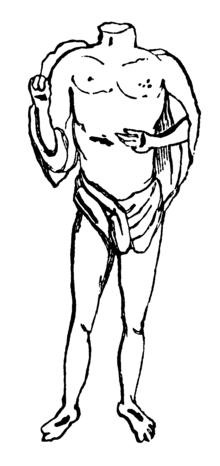Smart Lethieullier
Smart Lethieullier (3 November 1701 – 27 August 1760) was an English antiquary.

Early life and education
Lethieullier was born on 3 November 1701 at Aldersbrook Manor House, Little Ilford, Essex. His family was of Spanish Netherlands Huguenot origin, and had come to London as refugees in 1605. His grandfather, Sir John Lethieullier (1632/3–1719), had succeeded in trade, and had risen to become Sheriff of London in 1674–5, and owner of the Aldersbrook estate (purchased 1693). Sir John's son, also named John (d. 1737), married Elizabeth Smart, and Smart was their second son. He was educated at Eton College and Trinity College, Oxford, from where he graduated MA in 1723.
Antiquarian interests
Lethieullier subsequently travelled in France, Italy, Germany, and throughout Britain, and developed a passion for the study and collection of antiquities and fossils. He was elected a fellow of the Royal Society (1724), the Society of Antiquaries (1725), and a member of the Spalding Gentlemen's Society (1733). He developed a wide network of antiquarian and scientific friends and contacts, including Francesco Ficoroni, Bernard de Montfaucon, Richard Pococke, Andrew Ducarel, Francis Wise, Martin Folkes, Samuel Gale, Richard Mead and Peter Collinson.
He wrote numerous letters and papers on antiquarian topics. None were published in his lifetime, but a number appeared posthumously in Archaeologia (journal of the Society of Antiquaries) and elsewhere. His subjects included Roman remains (including those in the grounds of Wanstead House and neighbouring Aldersbrook Manor), the Ambresbury Banks hillfort, the shrine of St Hugh in Lincoln Cathedral, and techniques for the dating of English church monuments. In 1732–33, when he was living in Paris, he wrote the first detailed account in English of the Bayeux Tapestry: it was eventually published in 1767 as an appendix to Andrew Ducarel's Anglo-Norman Antiquities.[1][2]
In 1737, on his father's death, Lethieullier inherited Aldersbrook and began to improve the grounds, including the building of a hermitage in which to house his collections.
Public service
Lethieullier served as High Sheriff of Essex in 1758.[3]
Death and burial
Lethieullier died on 27 August 1760 at Aldersbrook, and was buried in St Mary's Church, Little Ilford.
Personal life
Lethieullier married Margaret Sloper in February 1726. She died in 1753: there were no children of the marriage. His estates were inherited by his niece Mary, daughter of his younger brother Charles.
References
- Hicks, Carola (2006). The Bayeux Tapestry: The Life Story of a Masterpiece. London: Chatto & Windus. p. 85. ISBN 0701174633.
- Brown, Shirley Ann (1988). The Bayeux Tapestry: History and Bibliography. Woodbridge: Boydell. p. 48. ISBN 978-0-85115-509-8.
- "No. 9760". The London Gazette. 24 January 1753. p. 1.
Sources
- Chown, C. H. I. (1926). "The Lethieullier Family of Aldersbrook House". Essex Review. 35: 203–20.
- Collinson, P. (1760). "Smart Lethieulier, Esq [Obituary]". Gentleman's Magazine. 1st series. 30: 443.
- Ellis, L. B. (April 1953). "The Lethieullier Family". Proceedings of the Huguenot Society. 19 (2): 60–67.
- Treasure, Geoffrey (2004). "Lethieullier, Smart (1701–1760)". Oxford Dictionary of National Biography (online ed.). Oxford University Press. doi:10.1093/ref:odnb/16522. (Subscription or UK public library membership required.)
External links
- Works by or about Smart Lethieullier in libraries (WorldCat catalog)
- Entry for Smart Lethieullier at the Royal Society